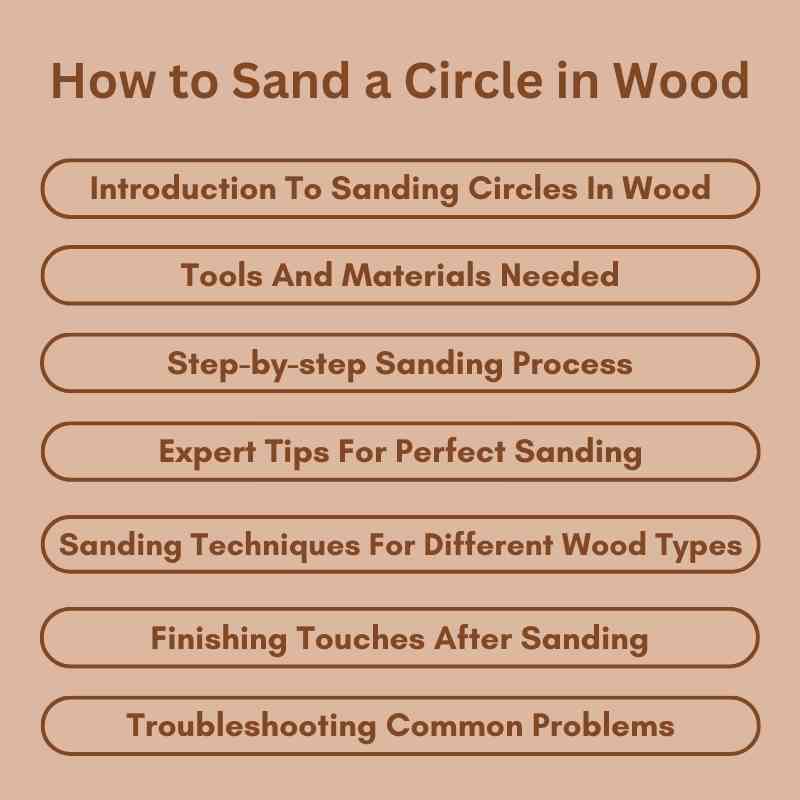To sand a circle in wood, use a jigsaw to cut the circle shape, then attach sandpaper to a sanding block. Move the block in a circular motion to achieve a smooth finish.
Sanding a circle in wood can be a satisfying project, whether you’re crafting furniture or decorative pieces. Achieving a perfect circular shape requires precision and the right tools. Woodworkers often face challenges in getting even surfaces without damaging the edges.
Understanding the correct techniques and tools can make this process easier. From selecting the right sandpaper grit to knowing the best motion to use, mastering this skill enhances your woodworking capabilities. This guide will provide you with essential tips and methods to sand a circle effectively, ensuring a professional-looking finish on your woodworking projects.
Introduction To Sanding Circles In Wood
Sanding circles in wood can be tricky. Maintaining a consistent curve requires skill and practice. The shape’s edges must be smooth and even. This demands precision to avoid mistakes.
Sanding in a circular motion helps achieve the desired finish. Using the right tools is crucial for success. Power sanders or manual sanding can be used, depending on preference.
Mastering this technique offers many benefits. It enhances woodworking skills and improves design accuracy. A well-sanded circle adds beauty to projects. This skill also boosts confidence in woodworking tasks.

Tools And Materials Needed
Choosing the right sandpaper is crucial for sanding circles in wood. Use medium-grit sandpaper, like 120 or 150. This grit removes rough spots without harming the wood.
For a smooth finish, select fine-grit sandpaper, such as 220. It helps achieve that polished look. Always test sandpaper on scrap wood first.
Essential sanding tools for circles include:
| Tool | Description |
|---|---|
| Orbital Sander | Great for even sanding on curved surfaces. |
| Sandpaper | Different grits for various sanding stages. |
| Hand Sanding Block | Helps with precise control on smaller circles. |
| Dust Mask | Protects lungs from fine dust particles. |
Preparing The Wood Surface
Start by cleaning the wood surface. Use a damp cloth to remove dust and dirt. Let the wood dry completely before proceeding.
Next, mark your circle accurately. Use a compass or a round object as a guide. Draw lightly with a pencil to avoid deep marks.
Check your marks to ensure they are even. Adjust if necessary to get a perfect circle. This step is crucial for a smooth sanding process.
Step-by-step Sanding Process
Start with rough grits like 60 or 80. These grits help remove large amounts of wood quickly. Use them to shape the circle and get rid of any imperfections.
Next, switch to finer grits such as 120 or 220. Finer grits smooth the surface. This step makes the wood feel nice to the touch.
For the last step, focus on sanding the edges smoothly. Use a small piece of sandpaper to round off the edges. This will prevent splinters and give a polished look.
Expert Tips For Perfect Sanding
Maintaining even pressure is key to a smooth finish. Move your hand in a circular motion. Keep the sander level to avoid dips. Press lightly to prevent gouges in the wood.
Avoiding common sanding mistakes can save time and effort. Don’t rush the process; take your time. Using the wrong grit can lead to rough surfaces. Always start with a coarser grit and progress to finer ones.
Remember to check your work often. Dust buildup can hide imperfections. Clean the area frequently to ensure a better outcome.
Sanding Techniques For Different Wood Types
Sanding techniques vary for hardwoods and softwoods. Hardwoods, like oak and maple, require fine-grit sandpaper. Start with 120-grit and finish with 220-grit. This prevents scratches and leaves a smooth finish.
Softwoods, such as pine and cedar, can handle coarser grits. Begin with 80-grit and progress to 120-grit. This helps to remove rough spots effectively.
Grain patterns also affect sanding. For straight grains, follow the wood’s direction. For wavy or irregular grains, use a gentle touch. This minimizes the risk of tear-out.
Always test your technique on a scrap piece first. This ensures the desired finish without damaging your project.
Finishing Touches After Sanding
After sanding, applying a finish is important. It protects the wood and enhances its beauty. Choose a suitable finish like varnish or oil. Use a clean brush to apply the finish evenly.
Allow the finish to dry completely. Lightly sand the surface again after drying. This helps achieve a smooth final layer. Repeat the process for a deeper shine.
Protect your work from dust and debris. Cover it with a cloth or plastic sheet. Keep pets and children away until it is fully dry. This ensures a clean and professional look.
Troubleshooting Common Problems
Uneven surfaces can be a common issue when sanding a circle in wood. Start by using a finer grit sandpaper. This helps smooth out bumps and rough areas. Always sand in a circular motion to maintain an even finish.
If you notice deep grooves, a coarse grit sandpaper can help. Gradually move to finer grits for a smoother surface. Remember to check your work frequently.
Scratches left after sanding can be frustrating. To fix them, use a sanding block. This helps apply even pressure. Always sand lightly over the scratched area.
For deeper scratches, use a wood filler. Apply it carefully, let it dry, and sand again. This method restores the wood’s original look.

Frequently Asked Questions
How Do I Choose The Right Sandpaper?
Choosing the right sandpaper depends on the wood’s surface and the desired finish. For rough surfaces, start with a coarser grit, like 80. Then, progress to finer grits, such as 120 or 220, for a smooth finish. Always test on a scrap piece before starting.
What Tools Do I Need To Sand A Circle?
To sand a circle in wood, you need a few essential tools. A jigsaw or bandsaw can cut the circle, while a palm sander or sanding block helps smooth the edges. Additionally, have sandpaper in varying grits for optimal results.
Safety gear like goggles is also recommended.
Can I Sand Wood Without A Power Sander?
Yes, you can sand wood without a power sander. Manual sanding with a sanding block or hand-held sandpaper works effectively. This method allows for more control, especially in intricate designs. It may require more effort, but it’s perfect for small projects or detailed work.
What Is The Best Technique For Sanding Circles?
The best technique for sanding circles involves a steady, even motion. Start with coarse grit sandpaper to shape the curve, then switch to finer grits for a smooth finish. Always sand in the direction of the wood grain. This prevents scratches and ensures a polished appearance.
Conclusion
Sanding a circle in wood can transform your project. With the right tools and techniques, achieving a smooth finish is easy. Remember to choose the appropriate grit and take your time. Practice makes perfect, so don’t hesitate to experiment. Happy sanding, and enjoy your woodworking journey!

